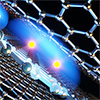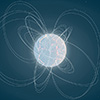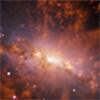Apr 24, 2024 (Nanowerk News) In a significant development in the field of superconductivity, researchers at The University of Manchester have successfully achieved robust superconductivity in high magnetic fields using a newly created one-dimensional (1D) system. This breakthrough offers a promising pathway to achieving superconductivity in the quantum Hall regime,...
A simple ‘twist’ improves the engine of clean fuel generation
Apr 24, 2024 (Nanowerk News) Researchers have found a way to super-charge the ‘engine’ of sustainable fuel generation – by giving the materials a little twist. The researchers, led by the University of Cambridge, are developing low-cost light-harvesting semiconductors that power devices for converting water into clean hydrogen fuel, using...
Eruption of mega-magnetic star lights up nearby galaxy
Apr 24, 2024 (Nanowerk News) While ESA’s satellite INTEGRAL was observing the sky, it spotted a burst of gamma-rays - high-energy photons - coming from the nearby galaxy M82. Only a few hours later, ESA’s XMM-Newton X-ray space telescope searched for an afterglow from the explosion but found none. An...
Feasibility of thin-film electronics for flexible chip design
Apr 24, 2024 (Nanowerk News) The mass production of conventional silicon chips relies on a successful business model with large ‘semiconductor fabrication plants’ or ‘foundries’. New research by KU Leuven and imec shows that this ‘foundry’ model can also be applied to the field of flexible, thin film electronics. Adopting...
How light can vaporize water without the need for heat
Apr 24, 2024 (Nanowerk News) It’s the most fundamental of processes — the evaporation of water from the surfaces of oceans and lakes, the burning off of fog in the morning sun, and the drying of briny ponds that leaves solid salt behind. Evaporation is all around us, and humans...
Scientists tune the entanglement structure in an array of qubits
Apr 24, 2024 (Nanowerk News) Entanglement is a form of correlation between quantum objects, such as particles at the atomic scale. This uniquely quantum phenomenon cannot be explained by the laws of classical physics, yet it is one of the properties that explains the macroscopic behavior of quantum systems. Because...
Making light ‘feel’ a magnetic field like an electron would
Apr 24, 2024 (Nanowerk News) Unlike electrons, particles of light are uncharged, so they do not respond to magnetic fields. Despite this, researchers have now experimentally made light effectively “feel” a magnetic field within a complicated structure called a photonic crystal, which is made of silicon and glass. Within the...
Testing how well biomarkers work
Apr 24, 2024 (Nanowerk News) Modern microscopy techniques make it possible to examine the inner workings of cells in astonishing detail. “We can now observe the arrangement and interaction of individual proteins under the microscope,” says Professor Ralf Jungmann, Chair of Molecular Physics of Life at LMU and Max Planck...
Giant galactic explosion exposes galaxy pollution in action
Apr 22, 2024 (Nanowerk News) A team of international researchers studied galaxy NGC 4383, in the nearby Virgo cluster, revealing a gas outflow so large that it would take 20,000 years for light to travel from one side to the other. The discovery was published in the journal Monthly Notices...
Identifying what causes electron-hole separation in thin-film cells to increase solar cell efficiency
Apr 22, 2024 (Nanowerk News) A team of researchers, including Kee-jeong Yang, Dae-hwan Kim, and Jin-gyu Kang at the Division of Energy & Environmental Technology, DGIST, collaborated with Professor William Jo at Ewha Womans University, Professor Jun-ho Kim at Incheon National University, and Dr. Sang-hoon Nam at the Department of...










